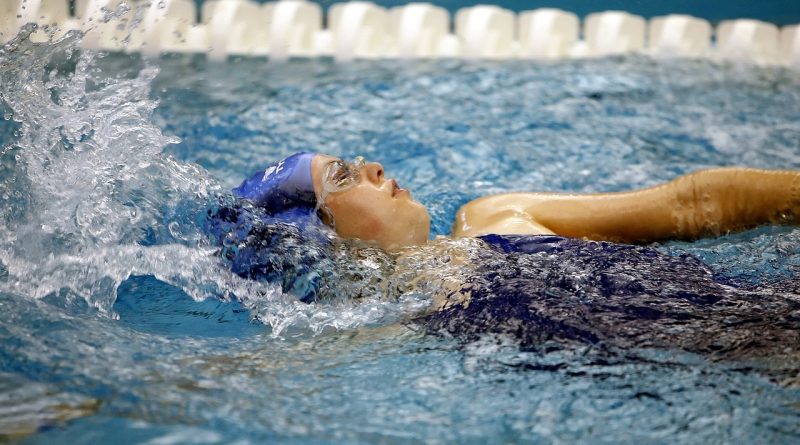Exploring swimming orientation – backstroke
When performed correctly, backstroke can be the most elegant and relaxed-looking of all the strokes. However, if a good head-neck-back relationship is not maintained, it becomes disorganized and awkward. Some swimmers pull their heads right back so that their eyes are focused on a point behind them, which can cause the back to arch unduly and water to spill over the face. Others crane their heads forward too far in an attempt to hold their face out of the water. This compresses the chest and puts a strain on the neck muscles.
Backstroke is performed with a regular arm action combined with a steady leg kick. The head and spine should remain centered, while the hips and shoulders constantly rotate, requiring free-flowing mobility of the hip and shoulder joints. The legs do not simply kick up and down at right angles to the water’s surface. During the stroke, they will mainly be angled to one side or the other, following the angle of the torso and lower body. The alternating arm-pull required for propulsion creates continuous alterations in the body’s lateral balance.
Controlling body-roll helps to preserve balance and freedom. Maintaining good orientation is the means whereby this can be achieved.
Practice the backstroke initially in three stages, to explore the optimum release of the neck muscles during its performance.
1. Push off from the poolside on your back, hands resting by your side. Your body should be slightly angled to one side. Release your neck muscles, letting your ears submerge, and discover how effectively the water can support your head if you allow it to. Experiment with minor changes in the angle of your neck to see how they can affect the way you float, noticing how holding up the head requires more effort than releasing the neck muscles.
2. Perform the same procedure with one hand gently supporting the back of your neck. With your hand feel the tone of the muscles in your neck as you experiment with different angles.
3. Perform the procedure this time with one arm extended behind you as you glide. Notice how much easier it is to float with the weight of the arm helping to balance the body along its length. Does this position have any effect on the sensation of release in your neck muscles?
Unlike the breaststroke, backstroke requires taking the arms out of the water and placing them back in. This is a process requiring fine control and unless performed with awareness and skill can have detrimental repercussions for orientation. The temptation is to arch the back. If we hold our arms stiffly or apply undue force, muscles become taut throughout the body. If the neck in particular is not relaxed, the head will tend to follow the movement of the arm around into the water, pulled both backward and from side to side by the powerful trapezium muscle which connects the neck, shoulders, and back. If the backward movement is too extreme, we risk water splashing over our faces. If the sideways movement is exaggerated, we increase resistance to our passage through the water and may disrupt the rhythm of our stroke.
Explore how well you can control the entry of your hand into the water. While neck and arm muscles should remain as relaxed as possible, the hand should be carefully directed into the water, little finger leading. This requires a rotation of the shoulders and a looseness of the neck to allow the head to move smoothly on its axis.
Orientation in the backstroke demonstrates the importance of the sculling action which characterizes most forms of propulsion in the water. Sculling means pushing sideways towards the body with hand and forearm so as to propel oneself forward on one’s front or backward on the back. After the arm enters the water, the elbow should drop so that halfway through the underwater phase the forearm can commence sculling. To do this requires a relaxed flexion of the elbow: a rigid arm cannot scull effectively. Furthermore, if the arms flail like windmills or propeller blades, their very rigidity will cause the strain and imbalance in the stroke that has been described.


